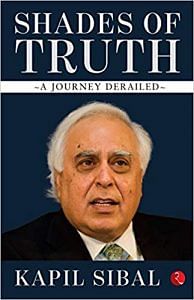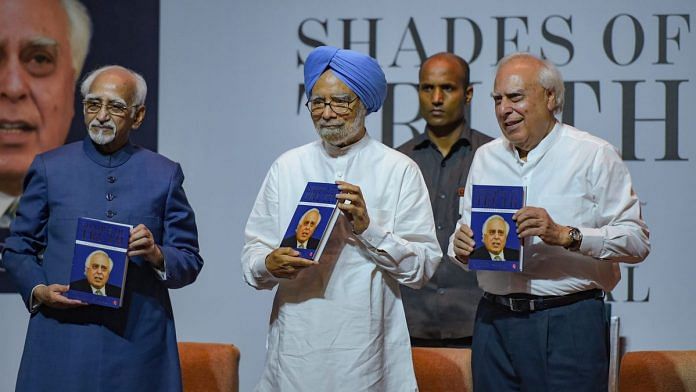Former union minister and Congress leader Kapil Sibal writes about the Modi era and how different it is from the UPA era in his new book ‘Shades of Truth’.
Destruction of key institutions
Post 2014, the calculated destruction of institutions is perhaps the most worrisome aspect of the Modi years. The RBI, always above suspicion, does not enjoy the kind of credibility that it had earned prior to demonetisation. It has failed to answer pertinent questions which exercise the public mind even today. The quantum of cash that RBI received post-demonetisation is still a mystery and so is its role when the decision to demonetise was announced on 8 November 2016. Authenticity of data is fundamental to decision-making. Its analysis determines policy prescriptions. Economists since 2014 have expressed doubts about the quality of data reflecting the state of the economy. Even GDP numbers are seriously doubted because of the painful reality on the ground. Institutional integrity of financial data, if suspect, strikes at the root of decision-making and subverts democratic processes.
Our judiciary too is under attack, as I have elaborated in Chapter 1. But the most worrisome aspect of this government’s disdain for democracy is the way it has ensured that central investigating and enforcement agencies do the government’s bidding. By selecting pliable officers and granting them unprecedented extensions, they have used these agencies to besmirch reputations. Opposition leaders are targeted and humiliated by having the agencies summon them. Charge sheets are not filed for years and investigations are kept pending only to tarnish images. When charge sheets are filed, they do not result in any conviction. The so-called 2G scam came apart with all the accused acquitted. The Maran brothers, though acquitted of the charge by the special CBI court of setting up a private exchange using the BSNL network, are required to face trial. Investigations are put on pause, opened and reopened depending on political designs and opportunistic alliances. No investigations are carried out when diaries are seized containing names of those at the helm of affairs in the BJP, who are alleged to be recipients of monies not accounted for. The excuse is that diary entries are not evidence. True, but evidence can be collected to be corroborated by diary entries. That is inconvenient for those wielding power. So, incriminating material found in the Birla and Sahara diaries are just not investigated because the agencies are caged, captive and have capitulated to the diktats of their masters. This also explains the protection of named persons in the Vyapam scam, in which those arrested are mostly parents and students, with politicians let off the hook. The U-turns by both the CBI and NIA speak volumes of the rot that has set in.
These fault lines undermining democracy could have been easily dealt with. An independent media would have exposed the government and turned public opinion against it. But a substantial part of the media has lost its credibility. Major events reflecting public angst against the government are excised by channels, as if they never happened. The media has become the government’s spokesperson. Lies when spoken by politicians of significance are neither investigated nor exposed. Instead they are repeated. Channels and media persons are threatened if they don’t take negative news off the screen. Sting operations that expose paid news and ideological predilections are not covered by the print or electronic media. It seems the government has some editorial control over the dissemination of news.
Coupled with the above is the social media onslaught of paid soldiers spreading fake news to polarise and incite violence. This has led to communal clashes and loss of lives—all this for political dividends. Added to this are the trolls abusing anyone saying anything negative about the government and propagating the virtues of Modi’s four years in office. All this shows that the building blocks of democracy are slowly but surely being dismantled. The destruction of democracy is afoot.
Battle of perception
The notion of presumptive loss, created by the then CAG, in the allocation of spectrum and coal blocks gave rise to allegations of scams of the highest order. Right decisions, even if there may have been individual aberrations, were portrayed as acts of vandalism by the Opposition. We were painted by the media as a corrupt lot, frittering away valuable national resources, benefiting specific entities, and were charged with crony capitalism. I believe all of this could have been defended. We should have stood up collectively to the decisions that we made. A few of us unsuccessfully attempted to justify our position. Unfortunately, we did not use the tactics which the present dispensation adopts. Today, when any news adverse to the government is placed in the public domain, the media refuses to pick it up. There is no explanation for this. Those in power can very well say that the media, in its wisdom, does not consider such adverse reports as valued news items, but the more probable explanation is the control this government exercises on both electronic and print media, which in turn, is owned by industrial houses, who constantly seek the help of government in their business and industrial enterprises. To my mind, this is the most quintessential form of crony capitalism because it creates a situation in which favours are granted if news is kept under wraps.
We could not halt the tide of misinformation because we chose not to exercise that kind of control and arm-twist those who disseminate news. The democratic fabric of this country and its sustenance is far more important than either the acquisition or the sustenance of political power. We cannot denigrate and stymie institutions which are pillars of democracy for the crass, political objective of self-aggrandisement of power.
This was not all. In the aftermath of these alleged scams, we witnessed the rise of a phenomenon that has now been eclipsed—Anna Hazare and all those who joined the bandwagon in an attempt to put in place a law that everybody has now conveniently forgotten. Hazare’s rise was facilitated by the universal belief that corruption was an issue that needed to be addressed immediately. There is no doubt that corruption is a major menace that needs to be dealt with on a war footing. But since the UPA government was already perceived to be corrupt in the public eye, the anti-corruption crusade, encouraged by its constant presence in the media, especially in the electronic media, created a situation in which Hazare and those who wished to ride on his shoulders sought from the government the creation of a committee to formulate a model law to deal with corruption. The government succumbed, which I believe was a mistake. The committee was set up and the outcome was ultimately reflected in the formulation of a model law by the Sense of the House Resolution in Parliament. During the course of the agitation, Hazare threatened the government and went on a fast unto death. The government relented, and the fast was broken. Hazare was taken into custody and the drama that followed in Tihar Jail resulted in his release. All these events portrayed the government as weak, unsure and defeated in its responses. No government can afford to portray that kind of image. This, along with the dramatics of Baba Ramdev, made the government look like it was not in control of the situation.
Our meeting with Ramdev at the Delhi airport was a big mistake. Our intent was different, but it was interpreted as if the functionaries of the government were afraid of Ramdev entering the capital and, therefore, sought to negotiate with him at the airport. The optics were hurtful to the government’s image and the outcome was worse. Ramdev reneged on the promise that he had made to the representatives of the government. Much was made of the events that followed at Ramlila ground. It was made to look as if the government was persecuting Ramdev.
The unfortunate Nirbhaya incident of December 2012, and the candlelight marches and skirmishes with the police that followed, again, portrayed the government as unresponsive. In a sense, the government was blamed for the dastardly act of brutal rape and murder of a young girl.
 This excerpt is from the book ‘Shades of truth: A Journey derailed’ which was published by Rupa Publications in 2018.
This excerpt is from the book ‘Shades of truth: A Journey derailed’ which was published by Rupa Publications in 2018.



